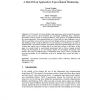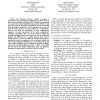26354 search results - page 130 / 5271 » How we refactor, and how we know it |
DSML
2008
13 years 11 months ago
2008
: Today's online model repositories offer to download and view the textual specifications of e.g. metamodels and models in the browser. For users, in order to efficiently sear...
PPOPP
2009
ACM
14 years 11 months ago
2009
ACM
Irregular programs are programs organized around pointer-based data structures such as trees and graphs. Recent investigations by the Galois project have shown that many irregular...
JUCS
2010
13 years 8 months ago
2010
: As ICT provide a lot of possibilities, high expectancies exist towards the electronic public service provision. All governments are increasingly establishing their e-strategies. ...
AINA
2010
IEEE
13 years 7 months ago
2010
IEEE
New transport protocols continue to appear as alternatives to the Transmission Control Protocol (TCP). Many of these are are designed to address TCP's inefficiency in operatin...
CHI
2010
ACM
13 years 10 months ago
2010
ACM
Researchers have detailed the importance of routines in how people live and work, while also cautioning system designers about the importance of people's idiosyncratic behavi...


